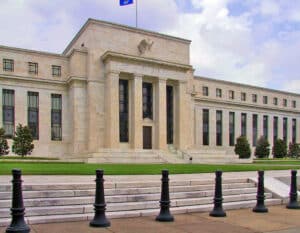The Federal Reserve will increase its benchmark interest rate by 0.75 percent, the central bank announced Wednesday afternoon, to a target rate of 1.5 percent to 1.75 percent. It’s the steepest increase since the 1990s.
In making their decision, Fed Chair Jerome Powell and other members of the interest rate-setting Federal Open Markets Committee had to grapple with an unexpectedly bad surge in consumer prices in May. In addition, a key monthly survey showed that Americans’ expectations for future inflation are rising, a sign consumers might accelerate purchases of some goods and increase inflation further.
In the lead-up to Wednesday’s announcement, observers expected either a half-percentage-point increase – consistent with Powell’s statements before the most recent inflation data was released – or a three-quarter-percent hike, with a few even floating the possibility of a full percentage point increase after the inflation report was released Friday.
Asked at a news conference Wednesday why the Fed was announcing a more aggressive rate hike than he had earlier signaled it would, Powell replied that the latest reports had shown inflation to be hotter than expected.
“We thought strong action was warranted at this meeting,” he said, “and we delivered that.”
The Fed’s monetary policy-makers expect their key rate, called the “federal funds rate,” to reach a range of 3.25 percent to 3.5 percent by the end of this year, making most loans significantly more expensive – likely the most expensive since 2008. The Federal Reserve is next scheduled to consider its benchmark interest rate on July 26 and 27.
Mortgage Bankers Association Chief Economist Mike Fratantoni said in a statement that “the Federal Reserve is racing to catch up to economic events”
“The ongoing reduction in the size of the Fed’s balance sheet, including its holdings of [mortgage-backed securities], is another factor putting upward pressure on mortgage rates,” he said. “The housing market has slowed considerably over the past month as rate increases have taken hold. We expect that this slower pace will remain through the summer, but buyers could return later this year if the Fed’s plans are better understood by the market and lead to less rate volatility.”
National Association of Realtors Chief Economist Lawrence Yun said in a statement that this year’s jumps in the average interest rate on a 30-year, fixed-rate home mortgage have sent the monthly payment on a hypothetical $300,000 loan up from 1,265 in December 2021 to $1,800 today.
“That’s painful and, consequently, will shrink the buyer pool,” he said. “Home sales have recently been trending down towards 2019 figures. Sales could fall even further with some inventory sitting on the market for more than a month like in the pre-pandemic days. Pricing a listed home properly will, therefore, be the key to attracting buyers. In the meantime, rental demand will strengthen along with rents. Only when consumer price inflation tops out and starts to fall will mortgage rates stabilize or even decline a bit.”
Powell told reporters at the Wednesday press conference that the Fed was “not trying to induce a recession now.”
“Let’s be clear about that. We’re trying to achieve 2 percent inflation,” he said, referring to the central bank’s longstanding internal inflation target.
Even if a recession can be avoided, economists say it’s almost inevitable that the Fed will have to inflict some pain – most likely in the form of higher unemployment – as the price of defeating chronically high inflation.
Inflation has shot to the top of voter concerns in the months before Congress’ midterm elections, souring the public’s view of the economy, weakening President Joe Biden’s approval ratings and raising the likelihood of Democratic losses in November. Biden has sought to show he recognizes the pain that inflation is causing American households but has struggled to find policy actions that might make a real difference. The president has stressed his belief that the power to curb inflation rests mainly with the Fed.
Yet the Fed’s rate hikes are blunt tools for trying to lower inflation while also sustaining growth. Shortages of oil, gasoline and food are propelling inflation. The Fed isn’t ideally suited to address many of the roots of inflation, which involve Russia’s invasion of Ukraine, still-clogged global supply chains, labor shortages and surging demand for services from airline tickets to restaurant meals.
Material from The Associated Press was used in this report.







